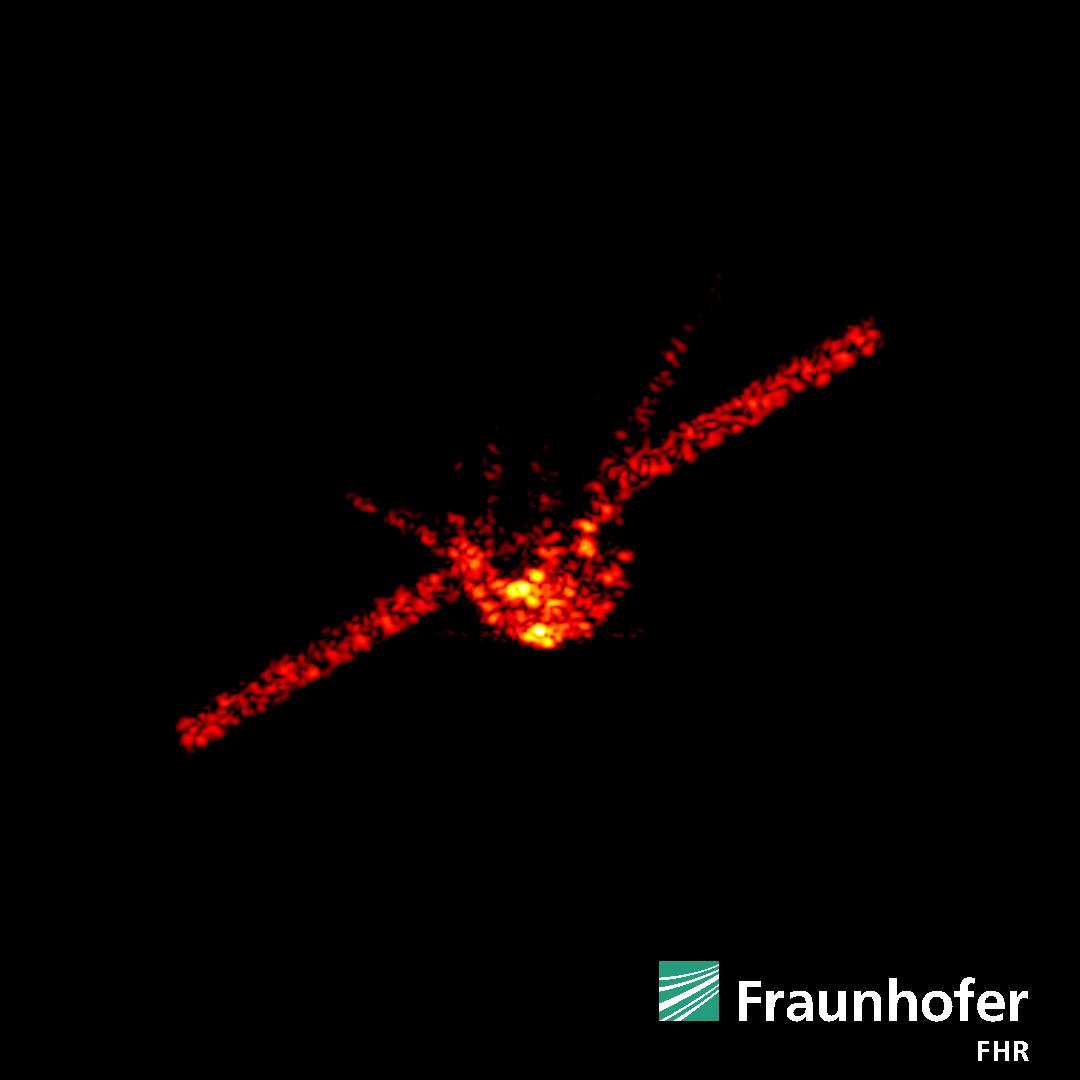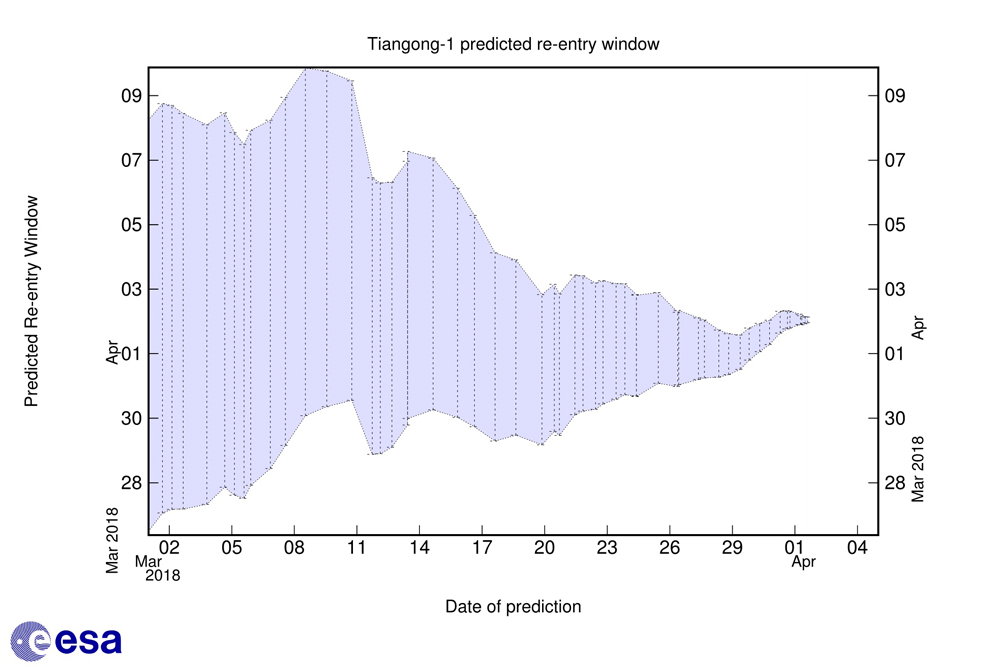How Was China's Tiangong-1 Space Station Crash Tracked So Accurately?

China's Tiangong-1 space lab burned up in the atmosphere over the southern Pacific Ocean late last night (April 1), falling right in the middle of the window predicted by a number of organizations, including the U.S. Strategic Command's Joint Force Space Component Command (JFSCC), the U.S.-based analysis group Aerospace Corp., the China National Space Administration and the Inter-Agency Space Debris Coordination Committee. The last organization is an international group that consisted of NASA and the European Space Agency (ESA), as well as the space agencies of 11 other nations.
Space.com talked with Harvard-Smithsonian's Jonathan McDowell, who has been commenting on the school-bus-size station's uncontrolled descent and predictions throughout the deorbiting process, to understand how agencies tracked the tumbling space lab.
"When we track Earth satellites, there are really three main ways to do it," McDowell told Space.com. "With radars on the ground, with telescopes, also on the ground, and with telescopes on satellites. For the most part, low-Earth orbit tracking is done with radars on the ground." [See China's Falling Space Station in These Radar Images]
In the U.S., for instance, there is a network of radars in the Northern Hemisphere that tracks objects in space as the world turns, he said. As satellites pass through the radar beams, scientists can get a sense of its distance from the radar source and its speed in the direction the radar is looking from. By combining observations from several radars, researchers can piece together a satellite's path.
"Of course, part of the fun is, if you saw a satellite 10 minutes ago with one radar, and you see a satellite now with another radar, how can you be sure it's the same satellite? It's actually quite a difficult problem … when you have 18,000 satellites going around, to disentangle them all," McDowell said. To do so, researchers have to model a rough orbit for the satellite, using radar data points to fine-tune their understanding of its location and speed.
Forecast
To forecast where a satellite like the falling Tiangong-1 is going next, researchers have to take into account the drag of Earth's upper atmosphere — a challenging feat, because that changes as the spacecraft tumbles at different angles and also as the atmosphere expands and contracts with temperature changes, altering from day to day and based on how active the sun is.
It's very difficult to precisely predict how an object like Tiangong-1 is tumbling. Researchers have to make do with an average impact of wind as it hits the object's different dimensions, and, though the actions of the atmosphere can be calculated based on what other satellites are doing, that method doesn't give instantaneous details.
Breaking space news, the latest updates on rocket launches, skywatching events and more!
Despite these limitations, the different organizations did a good job of predicting the window for Tiangong-1's descent, McDowell said. "For example, on the ESA site, which has this little graphic of how the window narrowed over time, it was never horribly wrong," he said. "It had big uncertainties to start with, and then it shrunk and shrunk until early on Sunday it was 6 hours, and later on Sunday it was 2 hours … and then we got re-entry, and it was pretty much in the middle of that 2-hour window.
"Science is not about being able to calculate things precisely," he added. "It's about being able to know how wrong you might be." He noted that while the time window was very accurate, the fact that organizations were saying exactly where it might come down was questionable — when a satellite is circling the Earth every 90 minutes and the window is 2 hours, there's not a strong basis to say one specific spot along that orbit (for instance, in the middle of the time range) is the most likely place for it to come down.
Additional stability was lent to the calculations because organizations were exchanging data, McDowell said: Every year, scientists in Europe, the United States and countries in other regions choose one spacecraft debris re-entry to compare data on and improve their models over time.
Final moments
But radar couldn't have given the precise moment of Tiangong-1's demise; the intervals between their coverage are too large. Instead, the JFSCC likely made use of U.S. infrared telescope satellites in geostationary orbit — a very high orbit that stays still over one part of the globe as the Earth turns. Those satellites are designed to spot missile launches and other unexpected launch events — "but they can also see forest fires, and they can see melting spaceships" like Tiangong-1, McDowell said. When the U.S. gives a precise time for a satellite's burn-up, he assumes it must have relied on such a view.
But the precision of the times given by China in particular raises an intriguing possibility, McDowell added: "I was very surprised that the Chinese knew when it came down. That's very interesting. What I think this means … is that the first Chinese missile-warning satellite is actually operational now," he said. "They launched it a year or so ago, and it's a big infrared satellite in geostationary orbit, and I'm betting that that's how they knew it came down."
And how did the process go over all? Pretty well, McDowell said, but tracking capabilities can still improve.
Currently, there aren't a lot of telescopes orbiting with the capability to track other satellites or orbiting objects — 10 years down the road, that's likely the main way they'll be tracked, McDowell said. And improvements in radars are also leading to better tracking over time.
"The problems we have — I don't think we need to particularly do better on these big ones," he said. "I think the process was fine; it worked as it was meant to do. The public would like things to be more predictable, and they would like 7-ton objects not to fall out of the sky, but sometimes that happens. Preventative stuff: Don't take risks with your spacecraft that might lead it to being broken before you can re-enter it."
But the larger problem, he said, is the smaller satellites such as cubesats, that are put in space in large numbers; many of them will fail and leave scientists with no way to track the satellites' locations. In the future, those could be required to carry transponders that would announce the satellites' locations even after failure.
"Measures like that would just improve our ability to know who's where in space, and not lose track of these things," McDowell said. "That's the coming argument that's going to be made."
Email Sarah Lewin at slewin@space.com or follow her @SarahExplains. Follow us @Spacedotcom, Facebook and Google+. Original article on Space.com.

Sarah Lewin started writing for Space.com in June of 2015 as a Staff Writer and became Associate Editor in 2019 . Her work has been featured by Scientific American, IEEE Spectrum, Quanta Magazine, Wired, The Scientist, Science Friday and WGBH's Inside NOVA. Sarah has an MA from NYU's Science, Health and Environmental Reporting Program and an AB in mathematics from Brown University. When not writing, reading or thinking about space, Sarah enjoys musical theatre and mathematical papercraft. She is currently Assistant News Editor at Scientific American. You can follow her on Twitter @SarahExplains.

